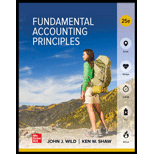
Concept explainers
Concept Introduction:
Journal entries-
The business runs with the transactions it makes. Every transaction results in some outcome like the creation of asset, liability, income, loss, gain or expense. The debits and the credits are made on the basis of the rules of the accounting.
To prepare:
To prepare the journam entry.
Concept Introduction:
Cost of goods sold -
Cost of goods sold can be defined as the total cost assigned to the goods that are sold during a period of time. It is calculated by summing up all the costs incurred starting from purchases till the process of manufacturing.
Adjusting entries are prepared to complete the financial statement of the company and to reflect the accrual method of accounting. Adjusting entries are prepared before issuance of financial statement.
Under or Over applied
Under or Over applied overhead- It is the difference between the actual and applied overhead.
If the actual overhead incurred is more than the overhead applied during a particular period, then it is a case of under-applied of overhead cost.
If the actual overhead incurred is less than the overhead applied during a particular period, then it is a case of over-applied of overhead cost.
To determine revised balance and to prepare the adjusting entry.
Concept Introduction:
Trial balance is an accounting statement which contains all debit and credit balances of the ledger accounts in which transactions have been posted during a period. It is prepared to check the arithmetical accuracy of transactions.
To prepare:
To prepare trial balance.
Concept Introduction:
Income statement-
Income statement refers to the financial statement that evaluates the financial performance of the company. It shows the expenses, revenues and net income of a firm over specific period of time. Therefore evaluation of financial performance can be undertaken by identifying the revenues and expenses incurred by the business through both non-operating and operating activities.
Balance sheet is a statement which shows the financial position of the company at a particular date. The balance sheet explains about the company's assets and also explains how these assets are being financed. Assets are usually financed either through debt or equity. So, balance sheet gives the clear picture of company's assets, liabilities and equity.
To prepare:
To prepare income statement and balance sheet.
Concept Introduction:
Income statement-
Income statement refers to the financial statement that evaluates the financial performance of the company. It shows the expenses, revenues and net income of a firm over specific period of time. Therefore evaluation of financial performance can be undertaken by identifying the revenues and expenses incurred by the business through both non-operating and operating activities.
Balance sheet-
Balance sheet is a statement which shows the financial position of the company at a particular date. The balance sheet explains about the company's assets and also explains how these assets are being financed. Assets are usually financed either through debt or equity. So, balance sheet gives the clear picture of company's assets, liabilities and equity.
To Analyse-
To analyse the impact of errors.
Trending nowThis is a popular solution!

Chapter 19 Solutions
Fundamental Accounting Principles
- Please provide the solution to this general accounting question with accurate financial calculations.arrow_forwardI need the correct answer to this financial accounting problem using the standard accounting approach.arrow_forwardCan you help me solve this general accounting problem with the correct methodology?arrow_forward
- Can you help me solve this general accounting question using the correct accounting procedures?arrow_forwardJob #508 used $3,500 in direct materials, 200 direct labor hours at $22 per hour, and overhead is applied at 150% of direct labor cost. Calculate the total cost of Job #508.arrow_forwardCan you solve this general accounting question with accurate accounting calculations?arrow_forward
- Rayburn Corporation has a building that it bought during year 0 for $850,000. It sold the building in year 5. During the time it held the building, Rayburn depreciated it by $100,000. What are the amount and character of the gain or loss Rayburn will recognize on the sale in each of the following alternative situations? Note: Loss amounts should be indicated by a minus sign. Enter NA if a situation is not applicable. Leave no answers blank. Enter zero if applicable. Problem 11-43 Part-a (Static) a. Rayburn receives $840,00arrow_forwardCan you solve this financial accounting question with the appropriate financial analysis techniques?arrow_forwardI need the correct answer to this general accounting problem using the standard accounting approach.arrow_forward
- Fenton Manufacturing Inc. had a variable costing operating income of $128,400 in 2023. Ending inventory decreased during 2023 from 45,000 units to 40,000 units. During both 2022 and 2023, fixed manufacturing overhead was $1,080,000, and 135,000 units were produced. Determine the absorption costing operating income for 2023.arrow_forwardWhat are the total product Costs for the company under variable costing?arrow_forwardQuestion 8-Barrow_forward

 AccountingAccountingISBN:9781337272094Author:WARREN, Carl S., Reeve, James M., Duchac, Jonathan E.Publisher:Cengage Learning,
AccountingAccountingISBN:9781337272094Author:WARREN, Carl S., Reeve, James M., Duchac, Jonathan E.Publisher:Cengage Learning, Accounting Information SystemsAccountingISBN:9781337619202Author:Hall, James A.Publisher:Cengage Learning,
Accounting Information SystemsAccountingISBN:9781337619202Author:Hall, James A.Publisher:Cengage Learning, Horngren's Cost Accounting: A Managerial Emphasis...AccountingISBN:9780134475585Author:Srikant M. Datar, Madhav V. RajanPublisher:PEARSON
Horngren's Cost Accounting: A Managerial Emphasis...AccountingISBN:9780134475585Author:Srikant M. Datar, Madhav V. RajanPublisher:PEARSON Intermediate AccountingAccountingISBN:9781259722660Author:J. David Spiceland, Mark W. Nelson, Wayne M ThomasPublisher:McGraw-Hill Education
Intermediate AccountingAccountingISBN:9781259722660Author:J. David Spiceland, Mark W. Nelson, Wayne M ThomasPublisher:McGraw-Hill Education Financial and Managerial AccountingAccountingISBN:9781259726705Author:John J Wild, Ken W. Shaw, Barbara Chiappetta Fundamental Accounting PrinciplesPublisher:McGraw-Hill Education
Financial and Managerial AccountingAccountingISBN:9781259726705Author:John J Wild, Ken W. Shaw, Barbara Chiappetta Fundamental Accounting PrinciplesPublisher:McGraw-Hill Education





